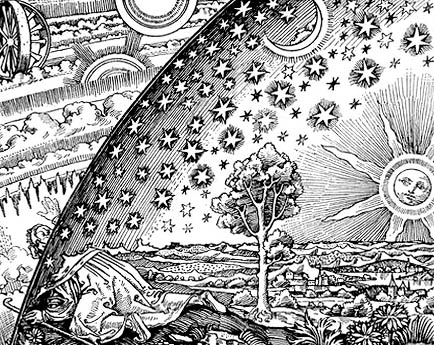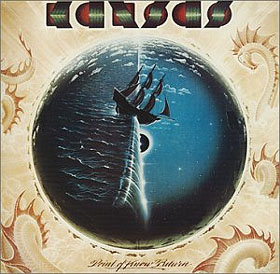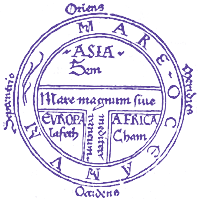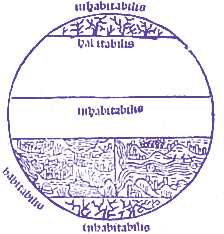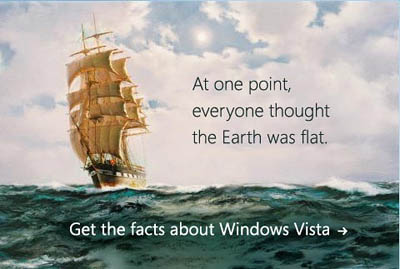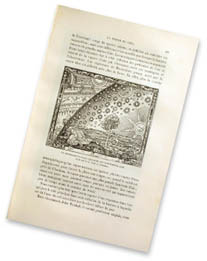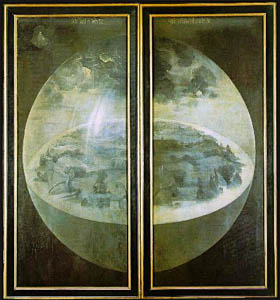|
The Earth is flat[ This text is also available in Swedish ] In the Middle Ages, everybody/the scholars/the church believed/claimed the world was flat
The Earth is indeed spherical, but for most practical, and even many less so, purposes, we can still consider it's surface flat. And if that works for us today, then obviously the people in the Middle Ages rarely, if ever, had to seriously consider the shape of the planet. Well, that would be when Columbus said he'd sail to Asia westwards, across the Atlantic. Boy, did they laugh at him! And off he went, with a crew that thought they were going to make the big leap, and discovered America. That certainly made some people look stupid! Right?
Quite the contrary. Everybody (virtually) who had an opinion in the matter knew the Earth was round. It was a non-issue. This fact is well known among historians today. Like Dick Harrison, professor of History: The truth is that no one mistrusted Columbus and that almost no medieval people believed the Earth was flat. Since the classical period, the prevailing consensus among educated Europeans was that the Earth was spherical. Almost all authors of western Europe who wrote about general geography - historians like Adam of Bremen, fiction writers like the author of "the traves of Mandeville" and members of the highest intellectual elite like Lambert of Saint-Omer - agreed that the Earth was round. What they didn't know was how big it was, or exactly what it looked like. (He's not quite right about Columbus though. He was indeed mistrusted, and for good reason, since his calculation of the distance to Asia was quite far off, from the correct distance as well as the generally accepted calculations of the time. And these were far better than most people today know or could make on their own; the most famous being the well-known of Eratosthenes ca 200 BC, and this was improved considerably by later and increasingly accurate measurements.) "Almost all", that is. One exception was Cosmas Indicopleustes in the sixth century. In his Topographia Christiana ("christian topography") he claimed that the tabernacle (the tent where the ten commandments were stored and worshipped, and which is described in detail in the Bible) was a model of the universe - the Earth being a flat surface with the heaven as a tent above. He also referred to e.g. Isiah 40:22:
The "tent to dwell in" indeed gives the impression of a flat Earth underneath. But the by far most discussed word here is the one that has been translated to "circle". In the latin Vulgate it's gyrum which also indicates a circle, orbit or similar, and the same sense is apparently found in the original chûgh, which also can mean e.g. compass. It is frequently stated that it could just as well be translated to "sphere" or "ball" but, well -- if you're a Christian apologetic who just can't stand the idea of the Good Book being wrong: then remember that theory, don't read further, and don't examine the Hebrew. The following quote might be another indication that people in the sixth century BC considered the world flat: Thus were the visions of mine head in my bed; I saw, and behold a tree in the midst of the Earth, and the height thereof was great. The tree grew, and was strong, and the height thereof reached unto heaven, and the sight thereof to the end of all the Earth Daniel 4:10-11 (King James) This world view according to Cosmas is often considered as the widely accepted in the Middle Ages. It was nothing like that. Harrison mentions that Cosmas wasn't translated to latin until 1663, "and thus remained unknown among educated medieval catholics" - who knew Greek as well, but Cosmas is never the less far more known today. No other supporter of the "world tent" theory is known. A more interesting name is Firmianus Lactantius, active around 300 AD. According to Harrison it is "impossible to measure the impact of Lactantius in the educated medieval word," but he ironically seems to have a considerably heavier, though indirect, impact today. The single best description of this factoid is Inventing the Flat Earth by professor Jeffrey Burton Russell. It is a thorough, well-written and highly recommended investigaton of "the Error" as he calls it. According to Russel, it began with Copernicus. In the refreshingly aggressive foreword of his revolutionizing De revolutionibus from 1543, Lactantius is mentioned as being as dull as those who believe the sun circles the Earth: Perhaps there will be babblers who claim to be judges of astronomy although completely ignorant of the subject and, badly distorting some passage of Scripture to their purpose, will dare to find fault with my undertaking and censure it. I disregard them even to the extent of despising their criticism as unfounded. For it is not unknown that Lactantius, otherwise an illustrious writer but hardly an astronomer, speaks quite childishly about the Earth’s shape, when he mocks those who declared that the Earth has the form of a globe. Hence scholars need not be surprised if any such persons will likewise ridicule me. ... Lactantium, celebrem alioqui scriptorem, sed Mathematicum parum, admodu pueriliter de forma terræ loqui, cum deridet eos, qui terra globi formam habere prodiderunt. What Copernicus did not claim was that common or educated people in general shared Lactantius view - quite the opposite - but that's the impression some readers appear to have got. Washington Irvings The Life and Voyages of Christopher Columbus (1828) contributed to the myth, by describing the criticism of the idea of "antipodes", and comparing Lactantius with Augustine: "who were considered in those days as almost evangelical authority" which is plain wrong, since Lactantius has never been anywhere near as well known as Augustine. But the idea of a symbolic battle between the Dark Ages, symbolized by the flat Earth, and the new, with Columbus being it's paladin. (Speaking of Copernicus, the debate that people erroneously assume took place about the shape of the Earth is often confused with the very real debate about whether we orbit the sun or the other way. The established view was indeed geocentric: the sun orbits the Earth.) Medieval princes, priests and merchants were certainly not characterised by the ignorant conservatism in geography and general culture that is often attributed to them in popular history, but they still didn't think very far ahead. Better bet your hard earned money on quick, realistic schemes than taking chances. Better attack a neighbour country or explore an existing coast (like West Africa) than investing in vague ideas. Dick Harrison [The upper layers of the laity in the fourteenth century] knew long before Columbus that the Earth was spherical, as concluded from the movements of the stars which could only be explained with a global Earth. This was described by the French priest Gautier de Metz in his widely read L'image du Monde, when he wrote that a human being could walk around the Earth like a fly around an apple. Barbara W. Tuchman The medieval church is well known for its faith in classic authorities, in particular Aristotle. (The episode about how Galileo asked a priest to take a look, but who refused with an explanation akin to "I've read Aristotle and he doesn't mention any sunspots" didn't, however, happen.) Since those authorities knew the shape of the Earth I don't know how people view their role in this context. A common argument for the biblical teaching of a flat Earth, in addition to Isiah 40:22 above, are some verses where "the four corners of the Earth" are mentioned (Isiah 11:12, Revelation 7:1). I don't know how the clergy of the Middle Ages interpreted this, only that it certainly wasn't enough to convince them of a flat Earth. Neither do I know whether the authors of the Old Testament had any opinion in particular regarding the shape of the world. An explanation that would work in their favour, so to speak, is that the Hebrew of e.g. Ezekiel uses the same word for "Earth" and "land", so maybe the expression only refers to the land of Israel? But this factoid isn't really about the Middle East BC but about Europe in the Middle Ages, and by then the spherical Earth had since long been an established and never questioned fact. In the days of Jesus, Roman scholars and sailors of the Mediterranean certainly knew that the Earth was round. I don't know what "the man in the street" believed, nor if or what the authors of the New Testament believed - only that they obviously didn't consider it important enough to put in writing. Considering the "four corners" mentioned before, which can also be found in their texts, one can also read (in Revelation 7:1, just after the four corners are mentioned) about "the four winds of the Earth" - that the wind should blow in four directions only is an idea which possibly haven't been discussed in length. From later times, there are also plenty of highly simplified "T-O maps", where no four corners can be found. (These too were never meant to be interpreted literally; people knew the continents didn't have perfectly straight edges, and so on.)
The non-existent debate on the shape of the Earth has also been confused with the debate on antipodes, that is whether people lived south of the equator. The church actually had an opinion in this strange matter: such races didn't exist. (Note that "antipodes" = anti-feet, that is people - today we use it in the geographical sense, on a diametrically opposite point on the surface of the Earth, but the existence of those weren't questioned.) Saint Augustine reasoned that since Genesis chapter 10 (which records the lands where the children and grandchildren of Noah decided to settle) doesn't mention any other continents than the good old ones, we can assume that no people lived in the unknown lands beyond the equator. Yet another reason was that the equatorial zone was somehow known to be not just warm, but so scorching as to be impassable. Thus, no descendant of Adam and Eve could have made the journey. Besides, didn't Jesus tell the disciples to go into all the world, and preach the gospel to every creature (Mark 16:15) - which would be quite impossible, had there been people in the unreachable regions beyond the global wall of fire. That's how the belief in antipodes became an unlikely heresy. (Knowing that the Earth is round doesn't make you brilliant.) But they [who claim that antipodes exist] do not remark that, although it be supposed or scientifically demonstrated that the world is of a round and spherical form, yet it does not follow that the other side of the Earth is bare of water; nor even, though it be bare, does it immediately follow that it is peopled. Nec adtendunt, etiamsi figura conglobata et rutunda mundus esse credatur siue aliqua ratione monstretur, non tamen esse consequens, ut etiam ex illa parte ab aquarum congerie nuda sit terra; deinde etiamsi nuda sit, neque hoc statim necesse esse, ut homines habeat. Augustine of Hippo A more significant supposed proponent of the biblical flat Earth is Johannes Chrysostomos (347-407). The evidence mentions "the four corners of the Earth" and other biblical quotes, but a trickier on can be found in a homily on Hebrews 8:1-2 which might be interpreted as the sky being likened with the tabernacle. Chrysostomos says: "Where are they who say that the heaven whirls around? Where are they who declare that it is spherical? For both of these notions are overthrown here." But what he argues about is, obviously, the shape of the sky, not the Earth. If he indeed considered the world flat, and perhaps used it as an argument against pagan round-Earthlings (as e.g. Cosmas did), evidence for this ought to be brought forward. In the middle of the upper hemisphere is Jerusalem. An unbearably hot region separates the three continents of the upper hemisphere from the world on the lower hemisphere, which is incorrectly said to house people called antipodes. The Frankish Benedictine monk Rabanus Maurus summarized the view of the world among educated catholics in the ninth century. The illustration below comes from Johannes de Sacroboscos De sphaera mundi, "On the sphere of the world" (this copy printed in 1490, the book was written ca 1230). Note that the south pole is upwards, and that Maurus and Sacrobosco apparently disagree on the location of Jerusalem - the middle of both hemispheres are labeled inhabitabilis, uninhabitable.
Nearly everything we know about the beliefs and world views in the Middle Ages stems from the intellectual elite, of which almost everyone belonged to the clergy. The sources have tantalizingly little to say of what "common" people, or quite uncommon as well, thought about things in general. What we have are a few glimpses; such as one brought to us by the previously mentioned John Mandeville, a kind of make-believe Münchhausen whose completely unreliable descriptions of exotic countries published in the fourteenth century were the bestsellers of the time: "The common man won't believe that one can walk on the underside of the Earth without falling into space." Or Petrus Jonae Angermannus, bishop of Växjö, Sweden, ca 1600, when the anti-feet had apparently got the green light: "Those called Anti-podes, the feet of which are turned toward our feet and their heads award from our heads, they too walk right, because their feet are turned towards the kernel of the apple, or the point in the middle of the Earth, and their heads toward the Heaven of their side. But this the simple and uneducated don't understand." And in Ludvig Holbergs Erasmus Montanus from 1731 the idea of the Earth being flat ("like a pancake") is even a part of the plot; here's a sample from act III, scene 2: Jesper: Is it true that in Copenhagen they believe that the world is round? No one believes that here in our village. How could it be? The world certainly seems perfectly flat. The dimwit flat-Earthlings of Copernicus still made good satire two centuries later. Whether it says anything about anything that significant numbers of real people actually believed in I do not know. It is, however, simple to show that at least scholars in the Middle Ages knew perfectly well that the Earth was round. They didn't even know it would much later turn out to be one of the greatest scientific issues in history - at least in the minds of the uneducated.
But what about this picture? Doesn't it show as clearly as possible that people once assumed that the world was flat? No. It was first published in 1888, in the book L'Atmosphere: Météorologie Populaire by the French astronomer Camille Flammarion. It has fooled a lot of people since it's supposed to look old - but isn't.
This one, however, is. It's a triptych (the two "doors" can be opened to reveal the three-piece painting "The Garden of Earthly Delights") by Hieronymus Bosch, ca 1504. Not that Bosch is known for hyperrealism... But whether he and/or the people who paid for the work considered the world flat or not, I'll end this article with it, as a symbol for all the people through the ages who indeed thought that the Earth is flat. The myth is that everybody, in particular scholars and sailors, shared the opinion, and also that there was a catholic doctrine on the subject that you had better follow, or else. Sources:
Thanks to Tore Kullgren for mentioning the Flammarion woodcut |


